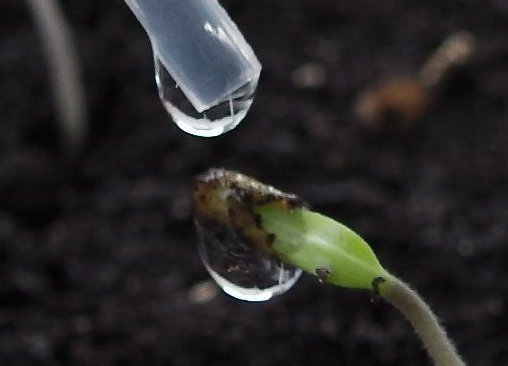Seeds and Germination
Easy tomato growing tips for getting started.
Tomato seeds take about six or seven days to germinate in the airing cupboard.
Using a small seed tray makes it a lot easier to find a warm place – a plastic food container is ideal.
It’s very important to move seedlings as soon as they germinate into a light position to stop them from becoming leggy.
Don’t over water – seedlings need very little water and are prone to diseases that are encouraged by wet cold soil and saturated roots.
Seedlings
When seeds germinate they often come through with their seed shell still attached to the seed leaves.

A propagator with lid helps because it keeps the air humid and prevents the seed shells from drying out.
If the lid of a propagator is kept on too long, the extra moisture makes the seedlings leggy – especially the first ones through. A dropper or pipette (as above) will help individual seedlings discard their seed shells when the lid is removed.
Sow Popular Varieties
It’s always a good idea to sow varieties that are popular such as Gardener’s Delight and Moneymaker. They are popular for a good reason, that is, they are reliable and most likely to succeed.
If you are new, or not so new to growing tomatoes, growing the larger varieties takes more experience and requires a good summer!
When To Sow
Timing is also an issue. Sow too soon and plants struggle through poor conditions. Sow too late and tomatoes won’t be ripe before the weather turns colder in the autumn. March to April is ideal.
Cleaning Equipment
A job that Isn’t much fun at the beginning of the season is cleaning and sterilising the equipment.

I’ve used the Jeyes fluid and one or two other similar products, but I’ve found the most convenient and least smelly option is household bleach.
It’s also much less expensive and it can be applied as a foliar spray. I usually dilute to about 20 parts water to 1 part bleach but don’t forget to read the label.
Pots for Seedlings
When transplanting seedlings into their first pot, instead of using tradition 3 inch pots, white plastic cups make a great alternative.
They are slightly deeper which is good for leggy seedlings, and narrower which means you can get more onto a tray.
Being white, they reflect light and of course they are very cheap to buy.
Propagation
The most economical way, if you grow around 30 or more plants, is probably a seed tray filled with compost. A lid is also useful to retain humidity when the seedlings germinate. The humidity inside the lid helps the seedlings discard their seed husks and helps prevent stress as the seedlings acclimatise.
Another inexpensive method, if you only need a few plants, is to use a grow pot/kit which you will find in a discount store. It includes seeds and a small amount of compost – just sow in the pot and that’s it!
Jiffy pellets are also a very good way to germinate seeds and you can buy these included with a propagator. The windowsill type is very popular and useful.
It’s fun to watch the jiffy pellets expand in a tray of water!
However, the ultimate way to germinate seeds and grow seedlings is by using Root-it sponges. These come in trays and also in a standard or windowsill propagator.
The advantage sponges have over other methods is the air and moisture ratio which helps develop a very good root system quickly.
Also, like jiffy pellets, there is no need for the roots to be disturbed when transplanting. There is also no need to buy bags of seed compost if sowing into pellets and sponges.
However, you can obtain good results whatever method you use.
Seedlings up to four weeks
In the first few weeks it is very important not to over-water seedlings. They will develop a better root system if they are slightly under-watered and encouraged to search for water with their roots.
Seedlings over four weeks
Transplant seedlings after around four weeks into their own small pots.
If you add perlite or vermiculite to the mix, you can water from above as there is no chance of compaction and removal of air.
Watering seedlings
If you are growing in seed compost or potting compost without perlite or vermiculite, it’s a good idea to water from below in a tray or saucer.
It’s also a good idea to allow compost to dry slightly to get plenty of air back into the root zone as the soil dries. Obviously, never allow soil to dry-out completely.
Over-watering will reduce air in compost, slow plant growth and root development and possibly cause root disease.
By allowing compost to dry-out a little just before transplanting helps to make the soil lighter and roots less likely to break.
Sow in small batches
It’s good to sow in small batches rather than the whole seed packet at once.
Germination failure
Sometimes, if temperatures become too hot in the airing cupboard or remain too cold for a few days (even indoors), seeds may fail to germinate and you’ll need to make another sowing.
Tomato plants are sub-tropical and vulnerable to frost.
Frost sensitive
You cannot leave tomato plants and seedlings out overnight until all danger of frost is past which in most areas of the UK is estimated to be around mid to late May.
As much light as possible
White reflective surfaces are a great help when growing seedlings – the extra light helps prevent them from becoming leggy.
Try not to over water
The temptation is to over water seedlings – once they have germinated, they probably won’t need any more water for a week or two.
Plug plants
Buying plug plants is the easier option but not as challenging though!

